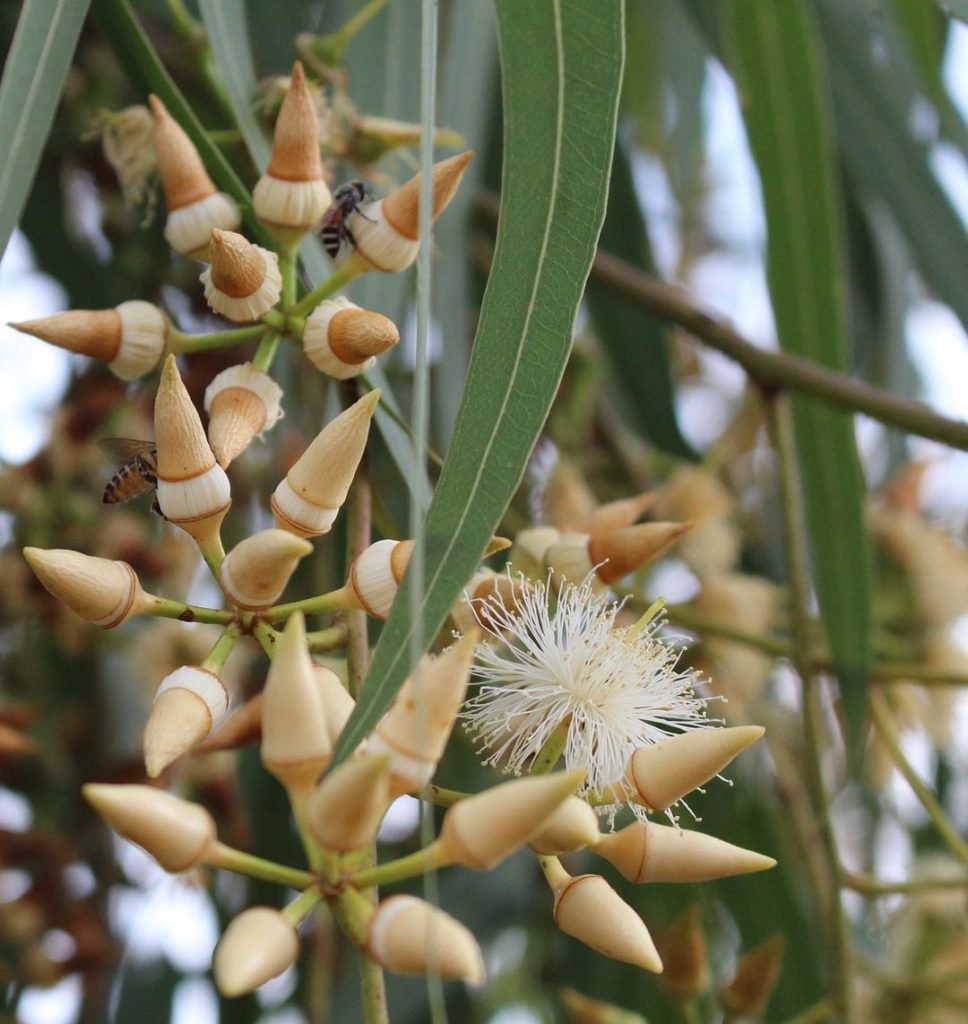
Australia
Eucalyptus
Eucalyptus radiata

General Description/Cultural Significance
Eucalyptus radiata is a graceful tree belonging to the Myrtaceae family that can reach a height of fifty feet or more. In the summer, it flowers in clusters of ten to twenty blooms. Its fibrous grey-green bark sheds in long ribbons. This genus of Eucalyptus has been utilized for its pharmacologic properties since Indigenous groups first inhabited Australia. The scent is fresh and is rich in the natural beneficial monoterpenoid compound eucalyptol.
There are over 700 species of eucalyptus in the country and most everyone would agree that it is their most significant scent. After much cultural input, the cineole-rich and highly medicinal Eucalyptus radiata, a narrow-leaved peppermint, was the single eucalyptus identified as most significant and memorable to the majority of people in the country. The leaves of several species are steeped in water to make an infusion to treat respiratory illnesses. Often wounds are covered in eucalyptus leaves to promote a healthy healing.
Eucalyptus species have had a long and penetrating effect on the culture in many ways, such as providing inspiration over the ages to many groups of people from authors and songwriters to scientists and architects. Eucalyptus is deeply embedded in the ways of Australians. The same is true for Tasmanians.
Climate Change/Conservation Status
Since the 2015 Climate Council report, Australia has been described as the driest inhabited continent on earth. The average annual temperatures are increasing, and so is the intensity and duration of the heat waves. Water restrictions are in place in many regions.
The Australian government announced in 2020 that the country has had its fourth-warmest year on record, with its annual national mean temperature 1.15ºC (34.7ºF) above average. Extreme heat waves and catastrophic bush fires, in addition to flooding, have taken many lives, human and animal, and left thousands upon thousands of acres decimated.
Researchers who studied what the rise in temperature would mean for 657 species of eucalypt trees found that 90 percent of the species will shrink in habitat range and distribution, and that the country will lose many rare endemic species and plants of eucalypt habitats in the next few decades. Within 60 years, Australia’s eucalyptus tree landscape will be dramatically altered and recent massive wildfires may have secured that fate.
Another ecological catastrophe caused by rising global temperatures is the mass bleaching events that have killed much of the Great Barrier Reef, a UNESCO World Heritage site. Its wondrous ecosystem comprises thousands of reef networks and hundreds of islands. But aerial views reveal the serious threat to the reef’s survival. Coral bleaching has affected over two thirds of the reef since 2015. Coral can recover, but scientists fear that the worst affected areas have been lost for good. It is not only the bleaching from global warming that is the problem. Pollution and runoff due to deforestation are also taking their toll. This is an example of the domino effect of climate change, and the relationship between terrestrial and marine habitats. Urgent conservation action is needed on many levels to enable its future survival.
On the bright side, the Victorian alps, known as the high country, has become Australia’s horn of plenty with farms growing nuts, fruit, berries, and corn, to name just some of its delicious produce, along with high yielding vineyards.
Australians, and Tasmanians too, consider Eucalypts as trees of life and part of their evolutionary heritage, providing a storehouse of benefits that must be passed on to future generations. But how to ensure a resilient ecosystem in the face of climate change is the question.
Alternate Name
Eucalypt
Gum Tree
Sources
The Australian Consulate General, New York, NY, The Embassy of Australia, Washington, D.C., and CSIRO Forestry and Forest Products, Canberra, Australia. This statement can be found on the World Sensorium original website.
Climate Council, 2017. Climate Council Annual Report 2015-2016. Climate Council. [website]
Cock, I.E., 2011. Medicinal and Aromatic Plants – Australia. Encyclopedia of Life Support Systems, pp. 1-173. [website]
Gillis, J., 2017. Carbon in Atmosphere Is Rising, Even as Emissions Stabilize. The New York Times. [website]
Global Justice Ecology Project, n.d. Koalas Struggle With Highly Toxic, Low Moisture Eucalyptus Brought on by Climate Change. Global Justice Ecology Project. [website]
Meat and Livestock Australia, 2016. Tasmania. Meat and Livestock Australia. [website]
NAP Global Essentials, n.d. Eucalyptus radiata. Naturally Australian Products. [website]
Parfit, M., 2000. Australia: A Harsh Awakening. National Geographic, pp. 2-31. [website]
Southwell, I.A., 1992. Eucalyptus leaf oils: Use, chemistry, distillation and marketing. Phytochemistry, 31, no. 6: 2193. DOI: 10.1016/0031-9422(92)80403-2.
Webb, L.J., 2009. The Use of Plant Medicines and Poisons by Australian Aborigines. Mankind 7, no. 2: pp. 137-46. DOI: 10.1111/j.1835-9310.1969.tb00398.x
Williams, K. J., & Potts, B. M., 1996. The natural distribution of Eucalyptus species in Tasmania. Tasforests 8: pp. 39-165. [website]

